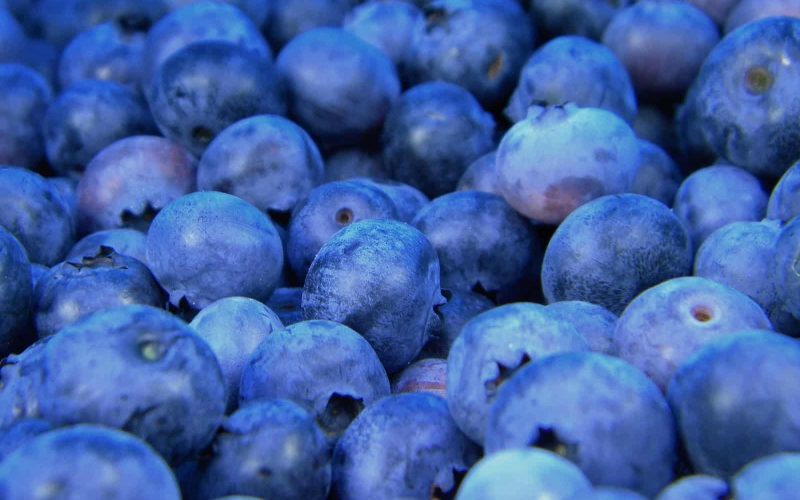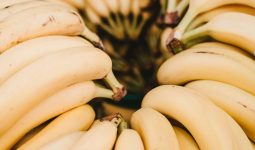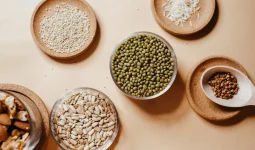Are you aware of blue foods? Despite being one of the least common food colors, it’s still one of the mightiest.
These foods are blue because they contain anthocyanins, an antioxidant found in plants. Anthocyanins give fruits and vegetables their red, purple, or blue hues.
Blue foods are good for us. They are rich in antioxidants and other nutrients that promote health.
Some studies suggest that consuming blue foods may reduce the risk of heart disease and cancer.
So, look at some of the best blue foods you can have.
1. Blueberries

Blueberries are probably the first thing that comes to mind when you think of blue foods. They are a common ingredient in muffins, jams, jellies, and breakfast cereals.
They have a low-calorie count, a high fiber content, and minerals, including manganese and vitamins C and K.
These tasty berries are also rich in anthocyanins, strong antioxidants that protect your cells from damage caused by unstable chemicals known as free radicals.
Blueberries are high in vitamins and minerals such as vitamin C, potassium, and fiber, which help keep your digestive system healthy.
Furthermore, studies suggest that diets rich in anthocyanins from blueberries and other fruits and vegetables may help prevent chronic diseases like heart disease, type 2 diabetes, cancer, and brain problems like Alzheimer’s.
2. Elderberries
Elderberry is one of the most widely used herbal treatments. This blue-purple fruit may strengthen the immune system, protecting against colds and flu.
It also aids in the recovery of certain illnesses. Research suggests that the beneficial plant chemicals in elderberries may activate healthy immune cells that help fight cold and flu viruses.
Depending on the growing method, elderberries can be certified as organic foods and used as an FDA-approved colorant.
These little berries are also excellent sources of vitamin C, vitamin B6, and iron. In addition, they have long been thought to have healing properties in treating mild illnesses, including colds, constipation, and other conditions.
Remember that cooking these berries may be the best option for eating them. However, elderberries eaten in immature or raw form could upset your stomach.
3. Concord Grapes
If you’re still trying to think of blue foods, look no further because Concord grapes are one of them.
This dark blue grape has the name of the town in Massachusetts where it originated.
You can eat concord grapes fresh as a table grape or use them to make juice and wine, just like other grape varieties.
They contain significant amounts of beneficial plant components that serve as antioxidants.
Contrary to popular belief, concord grapes have more chemicals than purple, green, or red grapes.
While further research is required, several studies suggest that eating Concord grapes and their juice may strengthen one’s immune system.
Concord grapes are typically used to make sacramental kosher wine. These blue fruits are high in antioxidants, which can help protect your skin, brain, and heart.
Additionally, several smaller studies indicate that drinking Concord grape juice regularly may improve memory, mood, and brain function.
4. Damson Plums
The damson plum is a little oval fruit with a distinct sour flavor. Depending on the type, the skin color of this plum can range from dark blue to indigo or nearly black.
The Damson name is from and most commonly applied to variants native to Great Britain. However, this plum is known as Jamblang in South and Southeast Asia.
Damson plums are useful in culinary applications such as fruit preservation and jam production.
They are abundant in vitamin C, and their dark blue skin is rich in anthocyanins, which give them antioxidant characteristics.
This fruit can also be dried to make prunes. Prunes are a common remedy for digestive issues, particularly constipation, which affects an estimated 14% of the global population.
As a result, consuming more prunes may increase your bowel frequency and soften your feces, making them easier to pass.
Plums also include plant components and sorbitol, a form of sugar alcohol that may help loosen your stools and promote more frequent bowel movements.
5. Blue Tomato
Tomatoes hardly come to mind when thinking of blue foods. But they exist.
The tomato plants that bear blue and purple fruit are healthier than your typical red tomato because they have been carefully bred to boost the health advantages of this common food.
They produce blue tomatoes with high quantities of anthocyanins, which give the fruit its blue color.
Blue tomatoes have a mildly sour flavor; you can eat them fresh like regular tomatoes.
You can also cook them with other foods, produce sauces, or blend them into a nutritious juice.
Several studies have shown that eating foods high in anthocyanins may reduce inflammation, guard against heart disease, and improve eye and brain health.
Observational studies link lycopene-rich diets to reduced heart disease, stroke, and prostate cancer risk.
6. Silver Quandong
The Silver Quandong, also known as the Blue Marble tree, is treasured in India. Its fruit features green flesh and brilliant blue skin.
You can consume it raw or remove the meat and blend it with water to create a paste for traditional medicine.
There are rumors that it cures epilepsy in some places. The fruit contains a seed that is useful in making necklaces and even rosaries.
7. Pansy
Pansies are common garden flowers in purple, white, yellow, and blue forms.
Because the name comes from the French word “pensée,” which means “thought,” pansies have been a symbol of thought throughout history, and sending pansies to someone means you are thinking about them.
While pansies look lovely in a garden or on a mantelpiece, the flowers are also edible and taste like lettuce.
They are a colorful complement to salads or sandwiches and, when covered with sugar, create a tasty cake topper.
8. Blue Corn
Blue corn, a Mexican and American Southwest cuisine classic, is among the blue foods. It provides 20% more protein than white maize and is used to produce blue tortillas and corn chips.
Blue corn kernels are colored blue due to anthocyanins, which have anti-cancer properties. Blue corn is available at most health food stores and online.
9. Blue Pea Flower Tea
The herbal butterfly pea flower tea, often Blue Tea, contains no caffeine. It has a flowery, slightly sweet flavor similar to chamomile.
The earthy flavor and mood-lifting properties of butterfly-pea flower tea make it popular.
In addition, the tea’s ability to relieve stress could ease anxiety symptoms.
It also contributes to weight loss, improved blood sugar regulation, and improved hair and skin health, among other health advantages. White rice can also be colored blue using the blue pea flower.
10. Blue Lingcod Fish
The blue lingcod is a species of freshwater fish native to North America. It resembles a ling and a cod, hence the name.
Blue lingcod is high in protein and omega-3 fatty acids. It is a Pacific Ocean bottom-dwelling fish. The blue color comes from biliverdin (a bile pigment).
11. Chesapeake Blue Crab
Chesapeake blue crab is also among the blue foods. Blue crabs feature white meat with a moderate salty flavor and a faint, sweet undertone.
Some believe blue crabs are superior to all other species due to their delicate texture and buttery flavor. Meats from backfins have the greatest taste, as they’re soft, flaky, and sensitive.
Chesapeake blue crabs can be found from the Atlantic coast of the United States down to Argentina. Their shells can grow to be up to 9 inches across.
12. Blue Eggs
Eight varieties of chickens lay blue eggs: Easter Eggers, Cream Legbars, Lushi, Dongxiang, Araucana chickens, Ameraucana chickens, and Arkansas Blue and Whiting True Blue chicks.
The blue coloration in the shells is due to high quantities of biliverdin, a byproduct of bile breakdown. These eggs provide the same protein and nutrients as normal chicken eggs.
13. Blue Oyster Mushrooms
Blue oyster mushrooms are edible fungi with a firm texture and a slightly sweet flavor. They contain antioxidants that help fight free radicals. This blue meal also contains vitamins B complex, C, and D.
14. Indigo Milk Cap
While checking out blue foods, you’ll come across different, pretty interesting foods. The indigo milk cap is one of them.
This colorful fungus grows naturally in Northeast America, East Asia, Central America, and Southern France. When fresh, it is dark blue and mild blue-gray as it grows.
When you cut the flesh of a blue mushroom, it oozes blue or indigo-colored milk, which gradually turns green when exposed to air.
The fungus is edible, though its flavor is bitter or peppery, and it is often consumed for novelty more than taste.
It has a grainy texture and highly beneficial saturated fatty acids, especially stearic acid. The fungus’s blue milk can be used to color marinades.
15. Haskap
This blue fruit also goes by other names such as blue honeysuckle, sweet berry honeysuckle, fly honeysuckle, blue-berried honeysuckle, and honeyberry. The plant is common in colder regions such as Canada, Japan, and Russia.
When this blue fruit is ripe, it will boost your vitamin C. Its rectangular shape sets it apart from other berries. Haskap can be used in ice cream, yogurt, jams, pastries, drinks, and other foods.
16. Borage
This flower takes the stunning star shape of its springtime flowers. Most borage plants have blue flowers, but some also have pink ones.
The flower is a fantastic addition to salads or as a garnish on your cuisine because it tastes similar to cucumber and adds a cheery color to your plate.
Borage has also been included in cocktails, desserts, and even ice cubes to add a touch of richness to a cool, refreshing beverage.
Borage seeds are quite popular in the food industry. They are used to make pansoti in Italy, grüne Soße in Frankfurt, and pickled gherkins in Poland and Russia.
The seeds, leaves, and flowers also serve as a source of herbal remedies. It helps treat asthma symptoms and includes high levels of gamma-linolenic acid (GLA), essential for skin health.
However, because some of the compounds in borage are metabolized by the liver, pregnant women, nursing mothers, and people with liver problems should avoid it.
17. Blue curaçao
This popular cocktail ingredient is among the blue foods. Laraha oranges, indigenous to the island of Curaçao, are used for flavoring.
It wasn’t until a Dutch manufacturer added the food dye Brilliant Blue that this famous Caribbean liquor acquired its distinctive blue color.
However, this beverage has no special health advantages due to its blue color; thus, it is advisable to consume it in moderation.
18. Blue Cheese
Blue cheese varieties are certainly an acquired taste; they often compete with one another for the title of “King of Cheeses.”
These cheeses get their blue veins and spots by culturing the mold Penicillium during the cheese-making process.
Roquefort, Gorgonzola, and Stilton are the most popular blue cheeses because they are strong, sharp, and salty.
However, with over 40 kinds to pick from, milder options are on the list, and blue cheese lovers are confident you will find one you like. You can melt or crumble the blue cheese into pasta recipes or spread it on bread.
18. American Lobster
Lobster is a common seafood meal. It is indigenous to the Atlantic Ocean and is present in all warm aquatic environments.
Although lobsters are often a muddy brown, green, or orange color, there is a 1 in 2 million chance that one will be blue due to rare genetic defects.
Even though most blue lobsters are not consumed due to their rarity, lobsters are delicious seafood, which is why this made our list of blue foods.
Furthermore, lobster meat is soft and has a mildly sweet flavor. It is a good source of protein, omega-3 fatty acids, and vitamins B12 and E. In addition, lobster contains nutrients, including zinc, phosphorus, and selenium.








